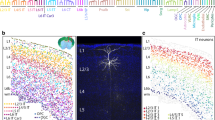Abstract
Astrocytes transport the monocarboxylate acetate, but synaptosomes do not. The reason for this is unknown, because both preparations express monocarboxylate transporters (MCT). The transport and metabolism of lactate, another monocarboxylate, was examined in these two preparations, and the results were compared to those for acetate. Lactate transport is more rapid in astrocytes than in synaptosomes, but of lower affinity (Kms of 17 and 4 mM, respectively). Lactate (0.2 mM) is metabolized to CO2 more rapidly in synaptosomes than in astrocytes (rates of 0.37 and 0.07 nmol · mg protein−1 · min−1, respectively). The reason for this is unclear, but cellular differences in lactate dehydrogenase isotype expression may be involved. Acetate is metabolized to CO2 more rapidly in astrocytes than in synaptosomes (rates of 0.43 and 0.02 nmol · mg protein−1 · min−1, respectively). This is likely due to cellular differences in the expression of monocarboxylate transporter subtypes.
Similar content being viewed by others
REFERENCES
Poole, R. C. and Halestrap, A. P. 1993. Transport of lactate and other monocarboxylates across mammalian plasma membranes. Am. J. Physiol. 264:C761–C782.
Garcia, C. K., Goldstein, J. L., Pathak, R. K., Anderson, R. G. W., and Brown, M. S. 1994. Molecular characterization of a membrane transporter for lactate, pyruvate, and other monocarboxylates: Implications for the Cori cycle. Cell 76:865–873.
McKenna, M. C., Tildon, J. T., Stevenson, J. H., Hopkins, I. B., Huang, X., and Couto, R. 1998. Lactate transport by cortical synaptosomes from adult rat brain: Characterization of kinetics and inhibitor specificity. Dev. Neurosci. 20:300–309.
Tildon, J. T., McKenna, M. C., Stevenson, J., and Couto, R. 1993. Transport of L-lactate by cultured rat brain astrocytes. Neurochem. Res. 18:177–184.
Bröer, S., Rahman, B., Pellegri, G., Pellerin, L., Martin, J.-L., Verleysdonk, S., Hamprecht, B., and Magistretti, P. J. 1997. Comparison of lactate transport in astroglial cells and monocarboxylate transporter 1 (MCT1) expressing Xenopus laevis oocytes. J. Biol. Chem. 272:30096–30102.
Waniewski, R. A. and Martin, D. L. 1998. Preferential utilization of acetate by astrocytes is attributable to transport. J. Neurosci. 18:5225–5233.
Lai, J. C. K. and Clark, J. B. 1989. Isolation and characterization of synaptic and nonsynaptic mitochondria from mammalian brain. Pages 43–98, in Boulton, A. A., Baker, G. B., and Butterworth, R. F. (eds.), Neuromethods, Vol. 11: Carbohydrates and energy metabolism, Clifton, NJ: Humana Press.
Frangakis, M. V. and Kimelberg, H. K. 1984. Dissociation of neonatal rat brain by dispase for preparation of primary astrocyte cultures. Neurochem. Res. 9:1689–1698.
Löscher, W., Böhme, G., Müller, F., and Pagliusi, S. 1985. Improved method for isolating synaptosomes from 11 regions of one rat brain: Electron microscope and biochemical characterization and use in the study of drug effects on nerve terminal γ-aminobutyric acid in vivo. J. Neurochem. 45:879–889.
Martin, D. L. and Shain, W. 1979. High affinity transport of taurine and β-alanine and low affinity transport of γ-aminobutyric acid by a single transport system in cultured glioma cells. J. Biol. Chem. 254:7076–7084.
Martin, S. B. and Martin, D. L. 1979. Stimulation by phosphate of the activation of glutamate apodecarboxylase by pyridoxal-5′-phosphate and its implications for the control of GABA synthesis. J. Neurochem. 33:1275–1283.
Reijnierse, G. L. A., Veldstra, H., and Van Den Berg, C. J. 1975. Short-chain fatty acid synthases in brain: Subcellular localization and changes during development. Biochem. J. 152:477–484.
Roughan, P. G. and Ohlrogge, J. B. 1994. On the assay of acetyl-CoA synthetase activity in chloroplasts and leaf extracts. Anal. Biochem. 216:77–82.
Bradford, M. M. 1976. A rapid and sensitive method for the quantitation of microgram quantities of protein utilizing the principle of protein-dye binding. Anal. Biochem. 72:248–254.
Marquardt, D. W. 1963. An algorithm for least square estimation of nonlinear parameters. J. Soc. Indust. Appl. Math. 11:431–441.
Bröer, S., Bröer, A., Schneider, H.-P., Stegen, C., Halestrap, A. P., and Deitmer, J. W. 1999. Characterization of the high-affinity monocarboxylate transporter MCT2 in Xenopus laevis oocytes. Biochem. J. 341:529–535.
Dienel, G. A. and Hertz, L. 2001. Glucose and lactate metabolism during brain activation. J. Neurosci. Res. 66:824–838.
Dimmer, K.-S., Friedrich, B., Lang, F., Deitmer, J. W., and Bröer, S. 2000. The low-affinity monocarboxylate transporter MCT4 is adapted to the export of lactate in highly glycolytic cells. Biochem. J. 350:219–227.
Gerhart, D. Z., Enerson, B. E., Zhdankina, O. Y., Leino, R. L., and Drewes, L. R. 1998. Expression of the monocarboxylate transporter MCT2 by rat brain glia. GLIA 22:272–281.
McKenna, M. C., Tildon, J. T., Stevenson, J. H., Boatright, R., and Huang, S. 1993. Regulation of energy metabolism in synaptic terminals and cultured rat brain astrocytes: Differences revealed using aminooxyacetate. Dev. Neurosci. 15:320–329.
Peng, L., Zhang, X., and Hertz, L. 1994. High extracellular potassium concentrations stimulate oxidative metabolism in a glutamatergic neuronal culture and glycolysis in cultured astrocytes, but have no stimulatory effect in a GABAergic neuronal culture. Brain Res. 663:168–172.
Walz, W. and Mukerji, S. 1988. Lactate production and release in cultured astrocytes. Neurosci. Lett. 86:296–300.
Bittar, P. G., Charnay, Y., Pellerin, L., Bouras, C., and Magistretti, P. J. 1996. Selective distributions of lactate dehydrogenase isoenzymes in neurons and astrocytes of human brain. J. Cereb. Blood Flow Metab. 16:1079–1089.
Laughton, J. D., Charnay, Y., Belloir, B., Pellerin, L., Magistretti, P. J., and Bouras, C. 2000. Differential messenger RNA distribution of lactate dehydrogenase LDH-1 and LDH-5 isoforms in the rat brain. Neuroscience 96:619–625.
Szutowicz, A. and Łysiak, W. 1980. Regional and subcellular distribution of ATP-citrate lyase and other enzymes of acetyl-CoA metabolism in rat brain. J. Neurochem. 35:775–785.
Tucek, S. 1967. Subcellular distribution of acetyl-CoA synthetase, ATP citrate lyase, citrate synthetase, choline acetyl-transferase, fumarate hydratase and lactate dehydrogenase in mammalian brain tissue. J. Neurochem. 14:531–545.
Fitzpatrick, S. M., Cooper, A. J. L., and Hertz, L. 1988. Effects of ammonia and methylene-DL-aspartate on the oxidation of glucose and pyruvate by neurons and astrocytes in primary culture. J. Neurochem. 51:1197–1203.
Author information
Authors and Affiliations
Corresponding author
Rights and permissions
About this article
Cite this article
Waniewski, R.A., Martin, D.L. Astrocytes and Synaptosomes Transport and Metabolize Lactate and Acetate Differently. Neurochem Res 29, 209–217 (2004). https://doi.org/10.1023/B:NERE.0000010450.21586.a6
Issue Date:
DOI: https://doi.org/10.1023/B:NERE.0000010450.21586.a6




